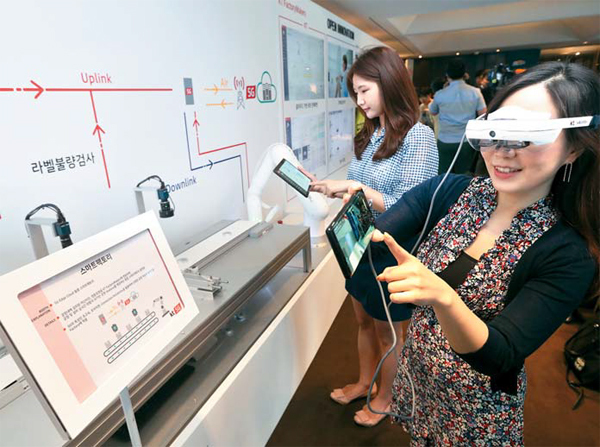[News Focus] After ‘Pokemon Go,’ what’s next for AR games in 5G?
Korean firms seek next mega-hit AR content to boost 5G, but absence of killer contents raises questions
By Yeo Jun-sukPublished : June 12, 2019 - 15:32
With companies around the world searching for new business opportunities with the fifth-generation cellular network, augmented reality appears to be a crucial technology in maximizing the effects of 5G, offering new content experiences to consumers, namely in gaming.
The country’s three major mobile carriers have been scrambling to find AR-based contents that could prove as popular as mega-hit game “Pokemon Go.” But questions linger as to whether the new network service will spark the rise of augmented reality, which has lately been losing steam.
While current 5G-based AR contents are mostly promotions designed to entice more 5G subscribers, the companies are pinning hopes on advanced 5G connectivity eventually churning out more appealing contents than before.

“Within the next two to three years, people will be wearing AR glasses instead of using smartphones,” SK Telecom’s Chief Park Jung-ho said during a press conference at Mobile World Congress 2019 in February.
The country’s biggest mobile carrier has established a united front with US tech companies in expanding AR services. During MWC 2019 in Barcelona, SKT signed a strategic partnership with display developer Magic Leap and “Pokemon Go” developer Niantic.
Particularly, SKT has been working closely with Niantic on its efforts to follow up on the global success of “Pokemon Go.” Instead of overlaying cute monsters onto a live view of the real world, the company aims to animate the Harry Porter universe in an AR experience with “Harry Porter Wizard Unite.”
SKT’s partnerships with the US companies are expected to yield exclusive marketing rights for the Korean telecom. SKT said Magic Leap’s new AR glasses can only be purchased in its stores, while its subscribers can enjoy “special benefits” when Harry Porter AR games become available this year.
“We haven’t determined yet what kind of special benefits will be, but it would be like something we did before,” said an official from SKT. When “Pokemon Go” became popular in 2017, SKT allowed its users to enjoy the game without charging fees for its data usage.
SKT rival KT came up with its own content similar to “Pokemon Go” to boost 5G subscriptions. In its “Catch Heroes” app released in April, users collect Marvel’s Avengers character cards when they find AR images near KT 5G base stations.
The telephone company is also seeking to incorporate AR technology into manufacturing processes. Last month, KT demonstrated how a smart factory solution could help identify flawed products through 5G-powered AR devices.
The company has announced a business plan for AR contents. By teaming up with local game developers and other contents producers, KT said it would create up to 100 billion won ($84.6 million) in market revenue from the industry.
“By 2020, we are hoping that AR market volume will expand up to 1 trillion won,” said Ko Yoon-jeon, who heads future industry at KT. “We are going to create 5G killer content that people can enjoy.”

K-pop stars also can be a good starting point for Korean companies to make a foray into AR business. LG Uplus recently introduced an AR-based service that allows users to dance along with a popular singer.
In “My Own 3d Stars,” LG Uplus subscribers can bring their favorite K-pop singers onto their smartphones. Through a video attached to the phones, users watch themselves dancing right next to the virtual image of their favorite stars.
Last week, LG Uplus showcased how the content was made. Dozens of special cameras and light-emitting diodes were installed to produce a 4K video of a dancer mimicking K-pop idol Chungha’s performance of “Gotta Go.”
“We want to tell our users why it is important to use 5G by showing how it changes the way they watch videos,” said Kim Min-gu, who is in charge of AR service at LG Uplus. “Through our apps, you enjoy Chungha’s performance from every angle you want.”
Step up from Google Glass hype?
This is not the first time augmented reality has been touted as the next big technology to shake up tech. When Google introduced its Google Glass several years ago, some predicted it would replace the smartphone in the near future.
But efforts to mass-produce easily accessible AR gadgets have been halted due to the price tag for the futuristic devices. Google Glass, for example, was priced at $1,500 when it rolled out in 2013.
Compounding the problem was a lack of enjoyable contents to make the device feel crucial to the users’ daily lives.
“Outside of ‘Pokemon Go,’ it’s hard for people to name AR games that they see their friends playing,” said an official working at a Seoul-based app developer. “They have to come up with contents that consumers feel are worth paying for.”
Since the global launch of “Pokemon Go” in summer 2016, a host of AR games have hit the markets. But none of them have captured the explosive success as the US game based on the long-running titular Japanese game and animation.
“Technologies and networks are there enough to support AR games, but their profitability still remains uncertain, making developers reluctant to begin with (when comparing other gaming formats like mobile games),” said an industry source.
The success of an AR game might be more about contents and how globally accepted they can be, beyond cultural and language barriers, not necessarily about a lack of technological progress.
“AR technology is applied to non-gaming programs such as an indoor golf simulator. I don’t think there’s a hit idea of how to make an AR game on mobile (platform) successful,” said Hwang Seong-ik, chairman of Korean Mobile Game Association.
Industry watchers expect that things would be different if the 5G network become more popular. They believe the hyper-speed, low-latency network could prove instrumental to AR technology hitting the mainstream.
Compared to the previous 4G LTE, 5G is much faster in processing the massive data required to embed virtual components into the real world. 5G is considered to be some 20 times faster than 4G with 100 times greater capacity.
Mobile carriers have expressed hopes that the heightened expectations of 5G would bring more players into the AR market. According to German market research firm Statista, the value of the AR market is expected to rise from $5.91 billion in 2018 to $198.17 billion in 2025.
“Of course, there is a price burden for telecom companies to produce all AR contents,” said Kim Joon-hyeong, who heads 5G service business at LG Uplus. “We are looking for a new business model by sharing the burden with other companies.”
(jasonyeo@heraldcorp.com)


















![[Today’s K-pop] Treasure to publish magazine for debut anniversary](http://res.heraldm.com/phpwas/restmb_idxmake.php?idx=642&simg=/content/image/2024/07/26/20240726050551_0.jpg&u=)